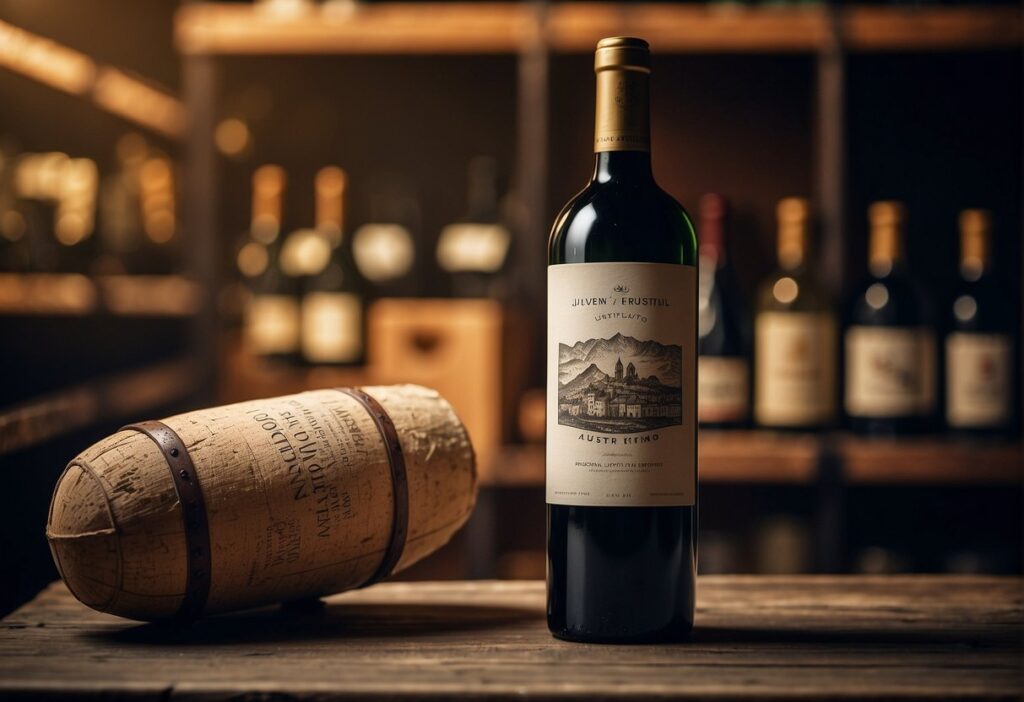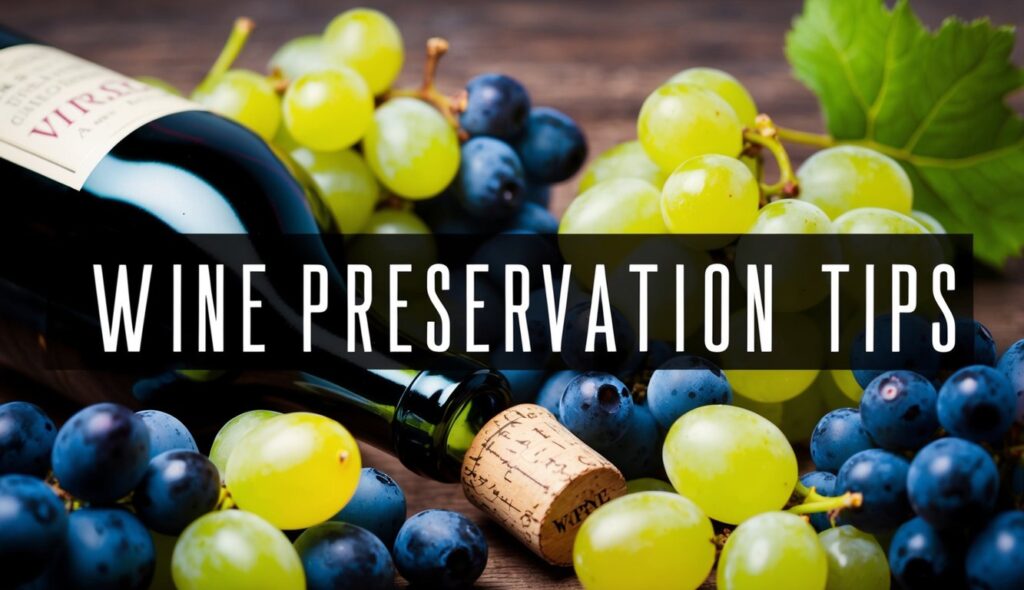When it comes to preserving the quality and flavor of your wine, the storage temperature is crucial. The ideal temperature to store wine is generally between 55°F and 59°F. This range helps slow down the aging process, keeping your wine in its best condition for years.

Storing wine in a professional cellar or a specialized wine fridge is often recommended. You don’t have to worry too much if it’s slightly warmer, as long as you plan to open the bottles soon. Maintaining consistency in temperature is key to preventing spoilage and preserving the complex flavors of each bottle.
If you’re just starting your collection or storing a few bottles at home, investing in proper storage pays off. Wines stored in a stable environment with 55% to 75% humidity age gracefully, offering you an exquisite tasting experience. The best practices ensure that each glass you pour is as delightful as the winemaker intended.
Principles of Wine Storage
Storing wine correctly ensures that it maintains its quality and flavor over time. Key factors like temperature control and the prevention of vibrations are essential for optimal storage conditions.
Understanding Wine Storage Temperature
Wine needs a stable environment to age well. The ideal wine storage temperature is generally between 45°F and 65°F. Many experts recommend aiming for about 55°F as a preferred point. This temperature helps the wine mature without spoiling.
Fluctuations in temperature can lead to premature aging or spoilage. Wine exposed to frequent changes may expand and contract within the bottle. This can lead to a compromised seal or even seepage. Keeping the temperature consistent is crucial for preserving wine quality over time.
Importance of Temperature Control
Temperature control plays a critical role in wine storage. Without proper regulation, wine can lose its intended flavor profile. A cellar or a wine cooler with temperature features can maintain the right conditions.
Vibrations should be minimized as they can disturb the sediment in the bottle. This could affect the wine’s taste and clarity. Using storage with low vibration levels helps maintain the wine in its best possible condition. Devices designed for wine storage often take these factors into account, offering optimal setups for wine enthusiasts.
Setting Up Your Wine Storage Solution
When setting up your wine storage, it’s crucial to focus on regulating both temperature and humidity. The right equipment ensures that your wine matures properly and maintains its quality over time. This section provides guidance on selecting appropriate wine storage devices and controlling the environment inside.
Choosing Wine Refrigerators and Coolers
Selecting the right wine refrigerator or wine cooler can make a significant difference in preserving your collection. These devices are engineered to maintain a consistent temperature, typically between 50° and 59°F for short-term storage, while long-term storage benefits from temperatures around 53° to 57°F. Such conditions prevent premature aging and spoilage, ensuring your wine matures gracefully.
Wine coolers come in various sizes, from small countertop units to large, built-in models. Consider the capacity and space available in your home. Think about the type of wine you mostly store; some coolers offer dual-zone systems, perfect for storing both reds and whites at optimal temperatures. When buying, look for features like adjustable shelving and UV-protected glass doors to protect from light exposure, which can harm wine.
Implementing Humidity Control
Maintaining proper humidity control is just as vital as temperature regulation. The ideal humidity level is generally between 55% and 65%, which keeps corks from drying out and prevents exposure to air, potentially spoiling the wine. Many wine refrigerators incorporate humidity controls that ensure these levels are met.
Adding a small, standalone humidifier to your storage area can maintain proper moisture if your device lacks this feature. Make sure to monitor humidity regularly using a hygrometer. Meanwhile, keeping the storage environment dark and stable will complement humidity efforts, reducing fluctuations that could affect your wine’s integrity.
Optimizing Storage Conditions for Different Wines

Proper storage conditions are essential to maintain the quality of both white and red wines. You’ll need to consider different temperature ranges and humidity levels to preserve their distinct flavors and characteristics.
White Wine Storage Considerations
White wines, such as Chardonnay or Pinot Grigio, should be stored at cooler temperatures. This helps maintain their crisp flavors. A range of 45°F to 50°F is suitable, preventing premature aging and keeping the wine fresh.
Keeping the bottles lying flat is important. This position keeps the cork moist and airtight. Moderate humidity around 70-75% prevents the cork from drying out, which can let air in and spoil the wine.
Stability is also crucial. Avoid frequent or sudden temperature changes, as they can lead to expansion and contraction, impacting the wine’s quality. It’s ideal to store your white wines in a wine fridge or a cool, dark cellar.
Red Wine Storage Essentials
For red wines like Merlot or Cabernet Sauvignon, you should aim for a warmer storage environment. The best range is 55°F to 65°F, which allows the wine to age gracefully, developing its flavors over time. Find more information in the wine storage temperature chart.
Always store red wines on their sides. This position ensures the cork remains moist. Consistent humidity levels around 70% are vital. This helps in preventing oxidation.
Darkness and stability are key. Red wines can be sensitive to light and temperature fluctuations. A wine cellar or a dedicated wine cooler can provide the necessary environment. It’s important to minimize vibration and movement to avoid disturbing the wine sediments, preserving its profile.
Advanced Strategies for Wine Preservation

When preserving wine, using professional storage services, applying long-term aging techniques, and understanding the impact of storage on wine quality are crucial. These strategies ensure your wine ages gracefully and maintains its flavor and value.
Professional Wine Storage Services
Professional wine storage services offer facilities designed to meet all the needs of long-term wine storage. They maintain the ideal temperature and humidity levels, typically between 53° and 57° Fahrenheit and 50% to 80% humidity levels, preventing premature aging and spoilage. Using these services ensures controlled conditions, shielding your collection from temperature fluctuations and light exposure.
Many facilities also provide insurance and security for your wine, addressing concerns about theft or damage. Some offer climate-controlled transport ensuring safe delivery to your home or cellar when needed. Utilizing these services can enhance your wine’s potential and ensure its quality is preserved over the years.
Long-Term Aging Techniques
For successful long-term aging, maintaining a stable environment is crucial. Store wine at a constant temperature, with 55° Fahrenheit often considered an ideal choice. It’s important to keep bottles on their sides, preventing corks from drying out and letting air into the bottle.
Light is another factor to avoid during storage. Dark storage spaces prevent degradation due to ultraviolet light. Humidity must also be regulated to ensure the cork stays moist without risking mold growth. A properly aged wine develops complex flavors, rewarding those who invest time and care into its preservation. Long-term aging transforms wines, allowing them to mature into their full potential.
Impact of Proper Wine Storage on Wine Quality
Proper wine storage directly influences the quality and taste of wine. Wines stored in optimal conditions maintain their intended flavors and aromas, whereas poor conditions can cause spoilage. The right combination of temperature, humidity, and lighting preserves the wine’s character.
Inappropriate storage can lead to issues such as cork taint or oxidation, which spoil the wine’s taste and aroma. By investing in proper storage, either at home or through professional services, you ensure your wine retains its quality and value. Effective storage practices guarantee that your wine experience is always enjoyable and true to the winemaker’s vision.
Maintenance and Monitoring of Wine Storage Environments

To achieve optimal wine storage, you must control the environment. Regularly check the temperature and humidity levels in your storage area.
For red wines, aim for a temperature between 55°F to 59°F. A stable environment prevents spoilage and ensures that your wine matures properly.
Wine coolers are a great investment for maintaining the right conditions. Choose a cooler with digital controls, allowing you to set and monitor the ideal temperature and humidity. This kind of precision helps keep your wine collection in top condition.
Use a hygrometer to measure humidity. Aim for levels between 55% and 65%. This helps prevent corks from drying out, which could affect the wine. If needed, add a humidifier or dehumidifier to adjust the environment accordingly.
Frequently inspect your storage area for consistent conditions. Use a checklist to regularly review temperature and humidity settings, ensuring they stay within the desired ranges. This proactive step helps in preserving the quality of your wine collection.
Wine storage tips include storing bottles horizontally to keep corks moist and using UV-filtering glass doors on wine coolers to protect against light damage. Proper organization also makes it easier to manage and access your collection without disturbing the aging process.

